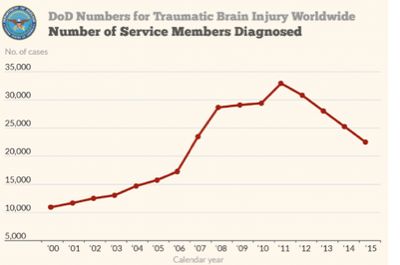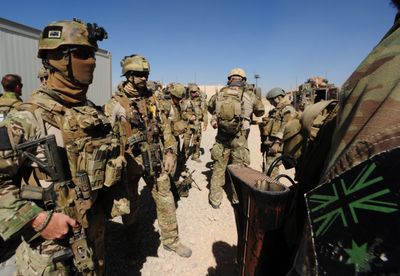Signed in as:
filler@godaddy.com
Signed in as:
filler@godaddy.com
The conflicts in Iraq and Afghanistan have heightened awareness of traumatic brain injury (TBI), particularly the mild and subconcussive forms. Numerous studies have attempted to estimate the incidence of deployment-related TBIs among service personnel. However, these estimates have largely relied on extrapolated datasets or subjective assessments, given the limitations of current diagnostic methods. As a result, obtaining accurate figures on both the rate and severity of deployment-related TBIs, as well as the incidence of multiple TBIs among service members, has proven difficult.¹
This underscores a critical need for a rapid, objective diagnostic method that can be deployed directly on the battlefield.
At present, researchers and clinicians must rely on estimates. For example, the RAND Corporation’s “Invisible Wounds of War” report (2007–2008) collected data from 1,965 previously deployed personnel and found that:
19.5% had suffered a “probable TBI”
This translates to approximately 320,000 of the 1.64 million service members deployed at the time
Yet, by the end of 2008, only 197,000 cases (12%) had been formally diagnosed, according to the Armed Forces Health Surveillance Center

Total TBI diagnoses US military, 2000-15.
Due to the complexities of both war and TBI, it has been extremely difficult to accurately measure the severity of TBIs or the incidence of multiple TBIs experienced by service members. The primary barrier is the absence of an objective method to determine brain injury. In 2006, the Military Acute Concussion Evaluation (MACE) was introduced as a screening tool for casualties.² While MACE has been well integrated into military medical protocols, it remains limited: it relies on subjective recall, is influenced by fatigue (similar to other neuropsychological tests), and demonstrates low sensitivity when administered more than 12 hours post-incident.³ Consequently, there is still a clear gap for an objective diagnostic method unaffected by confounding factors such as extracranial injury (polytrauma), stress, fatigue, or battlefield conditions.
Diagnosis
Diagnosing TBI—alongside associated post-concussive symptoms and comorbidities such as PTSD—presents unique challenges. Currently, no screening instrument can reliably provide a definitive diagnosis; the “gold standard” remains a comprehensive interview conducted by a skilled clinician. Even the current VA screening tool is designed only to initiate the diagnostic process, not to provide confirmation.
Cost
The financial burden is substantial. Among the approximately 1.6 million troops deployed since 2001, the costs associated with PTSD and major depression are estimated to range between $4.0–$6.2 billion over two years. Applying cost-per-case estimates for TBI to the total number of diagnosed cases reported as of June 2007 (2,726), the first-year costs alone were projected between $591 million and $910 million.4

Due to the complexities of war and of TBI, it has been extremely difficult to measure the severity of TBIs or the incidence of multiple TBIs service members are actually experiencing. The major reason is the lack of a method to objectively determine if the brain has been injured. In 2006 the Military Acute Concussion Evaluation (MACE) was add to the list of tools to screen casualties.2. While the MACE has been well integrated into the military medical evaluation, it still relies on subjective recall of the events, may be affected by fatigue as with other neuropsychological tests and has shown low sensitivity when administered greater than 12 hrs post incident.3. Thus there remains a gap for the ability to objectively measure brain injury with a method that is not impacted by this and other factors such as extra-cranial injury (i.e., polytrauma), stress, fatigue, and/or battlefield conditions.
Diagnosis
The diagnosis of TBI, associated post-concussive symptoms and other comorbidities such as PTSD, presents unique challenges for diagnosticians. No screening instruments available can reliably make the diagnosis; the 'gold standard' remains an interview by a skilled clinician. The current VA screening tool is intended to initiate the evaluation process, not to definitively make a diagnosis.
Cost
For the approximately 1.6 million troops who have deployed since 2001, it is estimated that PTSD-related and major depression–related costs could range from $4.0 to $6.2 billion over two years. Applying the costs per case for TBI to the total number of diagnosed TBI cases identified as of June 2007 (2,726), we estimate that total costs incurred within the first year after diagnosis could range from $591 million to $910 million.8.

Training and operational diagnostic tool.
1. Kara E. Schmid,Frank C. Tortilla. The Diagnosis of Traumatic Brain Injury on the Battlefield. Front Neurol. 2012; 3: 90
2. Meyer K. S., Marion D. W., Coronel H., Jaffee M. S. (2010). Combat-related traumatic brain injury and its implications to military healthcare. Psychiatr. Clin. North Am. 33, 783–796
3. Coldren R. L., Kelly M. P., Parish R. V., Dretsch M., Russell M. L. (2010). Evaluation of the military acute concussion evaluation for use in combat operations more than 12 hours after injury. Mil. Med. 175, 477–481